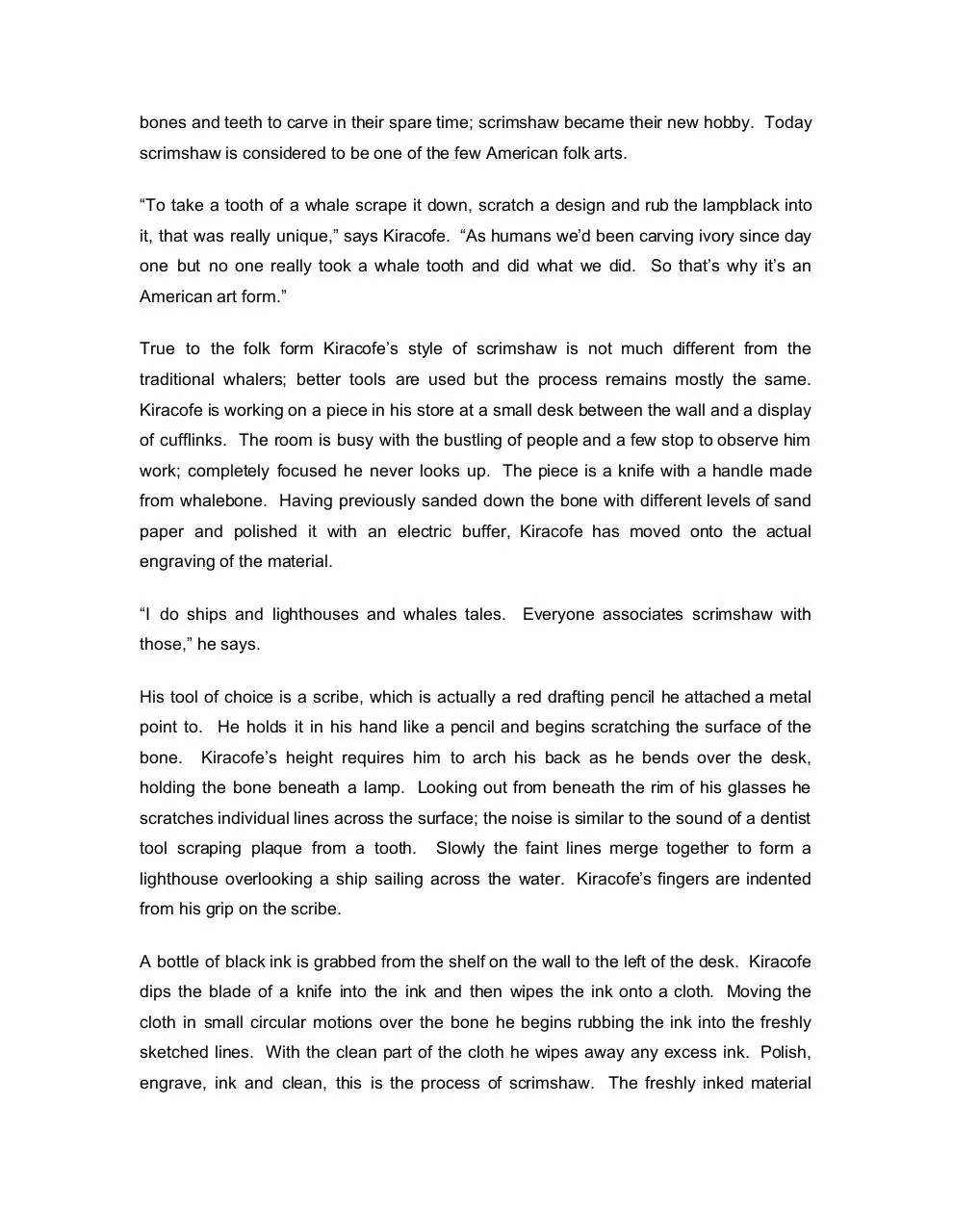Scrimshaw profile (1).docx (PDF)
File information
This PDF 1.5 document has been generated by / Skia/PDF m64, and has been sent on pdf-archive.com on 10/11/2017 at 18:15, from IP address 70.184.x.x.
The current document download page has been viewed 233 times.
File size: 79.52 KB (5 pages).
Privacy: public file





File preview
Courtney Gagnon - Feature Writing
Salve University
October 25, 2017
“They’re not going to find this at Wal-Mart”
A Local Man’s revival of a Forgotten American Art
The little shop feels smaller with the constant foot traffic; people are dodging into
Scrimshanders to escape the crowds outside but curiosity invites them to stay creating a
new crowd inside. Everyone makes a lap around the store following the display cases to
their left along the wall like a guide. The cases contain different items: canes, jewelry,
cufflinks, knives, pipes, lighters, display pieces and more. The varieties of objects are all
linked by a surprising fact: almost every item is made from bone or ivory. Upon closer
inspection people notice each piece is engraved with a design; intricate depictions of
mermaids and ships are scratched into the surfaces. The owner, Brian Kiracofe, hangs
back behind the cases, leaning slightly against the wall with his knee bent, letting his
customers explore the store. People compliment the quality of the work as they walk by
him. He tells them in a soft voice that each design is handcrafted; he even engraved
some of the pieces himself. The typical reaction is to get closer to the glass, some
practically pressing their noses up against it to get a better look. Knowing that each
piece was done by hand intrigues people; you cannot get these items just anywhere,
they are truly unique.
“I’m also an artist and I’m impressed,” says a customer.
She should be. Kiracofe is not a typical artist. He is a scrimshaw artist.
Scrimshaw is the art of engraving whalebone or ivory, although other material such as
walrus and elephant bone can be used as well.
American whalers developed the
practice during the 1700s. Whaling expeditions could last anywhere between three to
five years leaving the whalers with a lot free time and a desperate desire for a hobby.
Whales were being hunted to make oil from their blubber but their bones and ivory teeth
were not needed and often thrown overboard. Eventually whalers began keeping the
bones and teeth to carve in their spare time; scrimshaw became their new hobby. Today
scrimshaw is considered to be one of the few American folk arts.
“To take a tooth of a whale scrape it down, scratch a design and rub the lampblack into
it, that was really unique,” says Kiracofe. “As humans we’d been carving ivory since day
one but no one really took a whale tooth and did what we did. So that’s why it’s an
American art form.”
True to the folk form Kiracofe’s style of scrimshaw is not much different from the
traditional whalers; better tools are used but the process remains mostly the same.
Kiracofe is working on a piece in his store at a small desk between the wall and a display
of cufflinks. The room is busy with the bustling of people and a few stop to observe him
work; completely focused he never looks up. The piece is a knife with a handle made
from whalebone. Having previously sanded down the bone with different levels of sand
paper and polished it with an electric buffer, Kiracofe has moved onto the actual
engraving of the material.
“I do ships and lighthouses and whales tales. Everyone associates scrimshaw with
those,” he says.
His tool of choice is a scribe, which is actually a red drafting pencil he attached a metal
point to. He holds it in his hand like a pencil and begins scratching the surface of the
bone.
Kiracofe’s height requires him to arch his back as he bends over the desk,
holding the bone beneath a lamp. Looking out from beneath the rim of his glasses he
scratches individual lines across the surface; the noise is similar to the sound of a dentist
tool scraping plaque from a tooth.
Slowly the faint lines merge together to form a
lighthouse overlooking a ship sailing across the water. Kiracofe’s fingers are indented
from his grip on the scribe.
A bottle of black ink is grabbed from the shelf on the wall to the left of the desk. Kiracofe
dips the blade of a knife into the ink and then wipes the ink onto a cloth. Moving the
cloth in small circular motions over the bone he begins rubbing the ink into the freshly
sketched lines. With the clean part of the cloth he wipes away any excess ink. Polish,
engrave, ink and clean, this is the process of scrimshaw. The freshly inked material
reveals a more intricate image than the lines were able to show on their own. Small
details within the lines of the water and the ship become noticeable with the help of the
black ink. Leaning back in his chair Kiracofe stretches with his hands behind his head.
“Lots of little lines,” he says with a smile referencing the newly revealed details.
Despite this acknowledgement Kiracofe is modest about his work calling it commercial
and part of a production process. He does not consider his pieces to be fine art.
“Compared to a handful of scrimshaw artists that I work with that may only do 50 pieces
a year or 30 pieces a year, you know, those guys are doing the fine art version of that,”
he says. “With mine I might be able to do 50 pieces in two weeks. I’m making so many
small pieces so I do those designs over and over again.”
Kiracofe may spend less time on his pieces than other artists but according to his long
time employee, Taylor Clary, this does not affect the quality of his work.
“He’s constantly making something new.
It’s time consuming but he makes good
products,” she says. “Sometimes he complains, ‘ugh I just made that’ so I tell him if he
stops making such good products people will stop buying them.”
Kiracofe grew up in the small farming town of Gratis Ohio and was the youngest of four
boys. He was first exposed to scrimshaw while he was still in high school after his older
brother Daniel moved to Boston and picked it up as a hobby before opening up a store in
Faneuil Hall. Despite his interest in the art he decided to attend Lake Superior State
College in Michigan to pursue business. During college his interests moved back to
scrimshaw and he managed his brother Gary’s scrimshaw store in northern Michigan,
while also apprenticing with both brothers to learn the trade. Scrimshaw became a
one-generation family business.
“Everybody wants to hear that my dad was a whaler or my grandfather was a whaler but
no. We’re a farming family turned scrimshaw,” Kiracofe says.
After graduating in 1981, Kiracofe went to work in Daniel’s store in Boston. He was
recruited by the developers of Baltimore Harbor and opened a store there in 1982. After
a few years Kiracofe needed a change in setting and began looking for a new store
location including all options from Mystic to Maine. Eventually he settled on Newport
Rhode Island and opened Scrimshanders in 1986.
Despite him and his brothers’ success in the business, Kiracofe considers scrimshaw to
be a dying art.
Scrimshaw had actually already died in the early 20th century but
experienced a revival during the 60s and 70s after it was discovered that John F.
Kennedy was a collector; he was even buried with a whale tooth. The newly enacted
Endangered Species Acts, however, made it difficult for people to access materials and
many people dropped the art. Due to the laws, scrimshaw artists are limited to antiques,
buying already owned material from collectors. This requires many years of hunting
down collectors and forging connections.
“There’s not that many of us in this business so it’s about developing a network,”
Kiracofe says.
The difficulties caused by the restrictive laws surrounding endangered species lead
Kiracofe to acknowledge the unlikelihood of new generations joining the scrimshaw
business. Scrimshaw artists face five years in prison and a half million-dollar fine if they
violate these laws.
“If I was a young person I’d be going: ‘really they put you in jail for this? Yeah I don’t
think so.’ That’s why a lot of them don’t want to mess with it,” he says.
Even more upsetting than the dying of scrimshaw is the unfortunate result of the death of
craftsmanship. Our lives today are a product of mass production and importation. Items
are not made in America and they certainly are not made by hand.
“It’s sad to see,” Kiracofe says. Kiracofe wants to bring people’s attention back to the
beauty of craftsmanship with the pieces in his store.
“Our approach is to engage because if you just let people walk in and walk out some of
them have no idea that it’s hand done or they think it’s from China,” he says.
In his store Kiracofe takes the time to answer questions, always making himself available
to customers. When people come into his store Kiracofe helps them to understand what
they are buying and exposes them to the history surrounding his work. He wants
customers to recognize the uniqueness of his products.
“They’re not going to find this at Wal-Mart or anywhere in their hometown,” he says. “I
want them to come away with the fact that they bought something made here that was
originally from this region.”
Moving back to his work desk Kiracofe returns to the piece he was working on earlier.
His scribe moves in linear motions to create the faint image of the Newport Bridge
stretching across the background of the scene. What could be a more local image than
that around here? Looking around it becomes apparent he depicts it in a lot of his
pieces. Suddenly the image feels symbolic. Maybe the bridge that connects people with
the past of a historical city can also help reconnect people with the lost art of scrimshaw.
For now, Kiracofe keeps the American folk art alive with every stroke of his scribe.
Download Scrimshaw profile (1).docx
Scrimshaw profile (1).docx.pdf (PDF, 79.52 KB)
Download PDF
Share this file on social networks
Link to this page
Permanent link
Use the permanent link to the download page to share your document on Facebook, Twitter, LinkedIn, or directly with a contact by e-Mail, Messenger, Whatsapp, Line..
Short link
Use the short link to share your document on Twitter or by text message (SMS)
HTML Code
Copy the following HTML code to share your document on a Website or Blog
QR Code to this page

This file has been shared publicly by a user of PDF Archive.
Document ID: 0000695790.